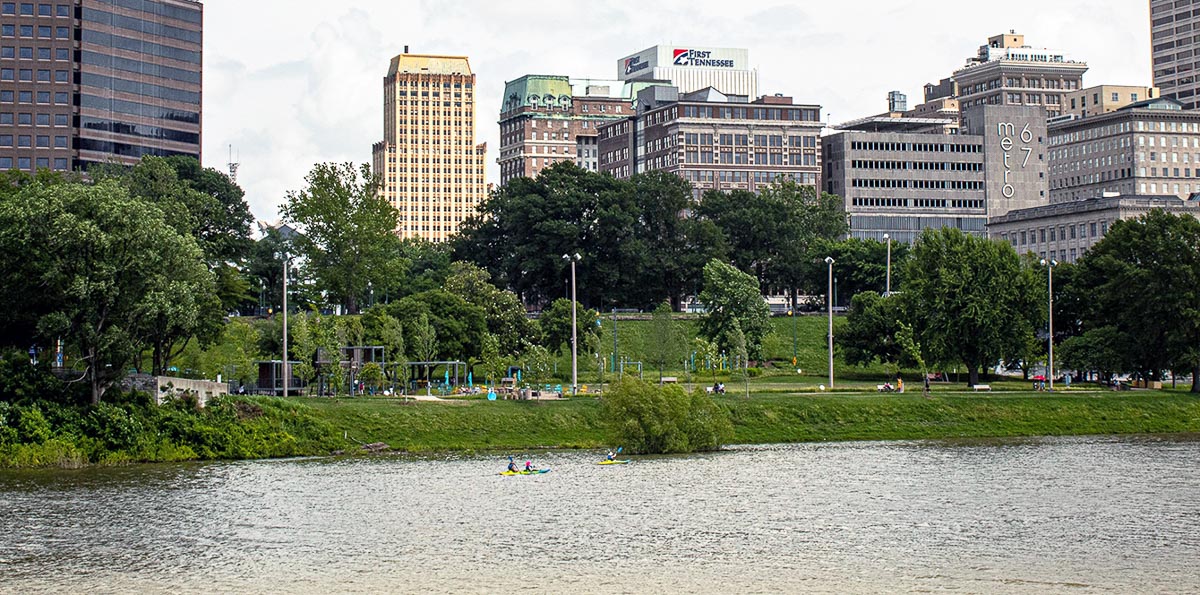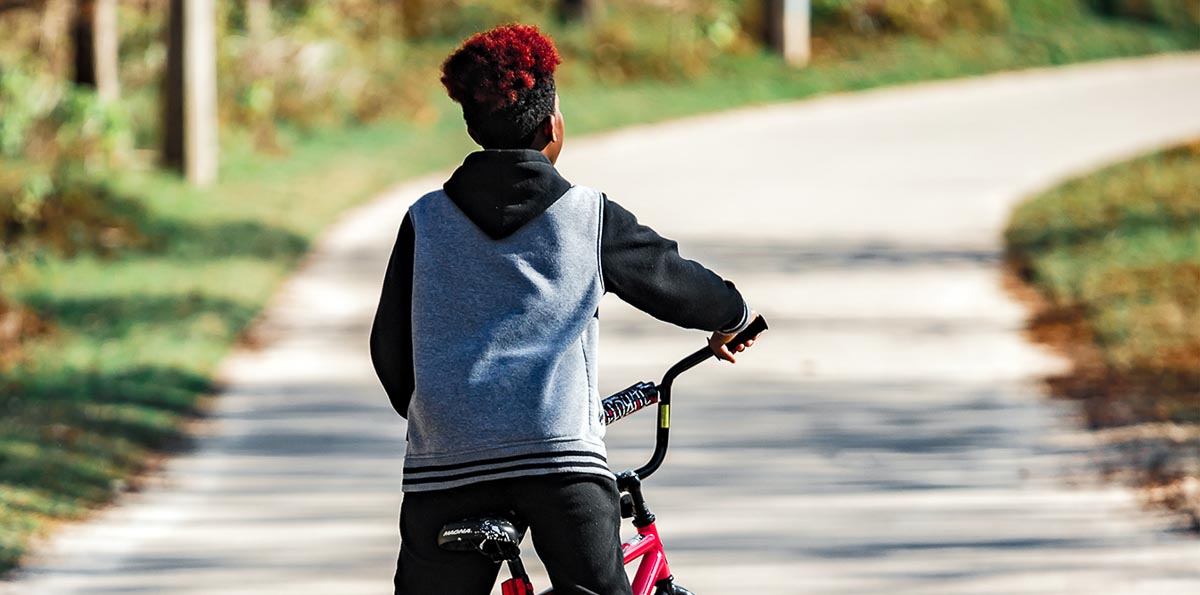Carol Coletta, president and CEO of the Memphis River Parks Partnership and a thought leader on urban issues, believes in the power of civic commons to benefit the common good.
In a 2018 talk she gave for the Kinder Institute Forum lecture series, Coletta discussed the role revitalizing and connecting public places plays in building cities that are stronger and more inclusive. Unfortunately, in many places, underinvestment and apathy have diminished civic assets such as parks, plazas, pools and libraries to the point they no longer connect residents and anchor neighborhoods.
Every city should have a “glamour project,” she told an audience at the Museum of Fine Arts a big-picture, public-space initiative that will benefit all residents. She pointed to the Bayou Greenways 2020 initiative as an example. When it’s completed, the ambitious public-private project will be a 150-mile network of connected linear parks and trails along nine bayous. The 3,000-acre system is so extensive that 1.5 million Houstonians will live within 1.5 miles of a bayou greenway. Mayor Sylvester Turner calls the project the “single biggest down payment on park equity in Houston.”
It will also help preserve permeable surfaces and reduce the area’s vulnerability to flooding.
Below, Coletta reflects on the role of parks and public spaces in meeting the key challenges of our time, overcoming social distance and building stronger and more successful communities. This originally was published on the City Observatory’s website.
Memphis is investing in equity
These past six months have been more challenging to downtowns than any I remember — and I’ve been working on, investing in and living in downtowns for almost half a century. We are being asked to reconsider everything we believe about downtowns — why they are important, and how they work.
Not one of us really knows how this will all turn out. But I am going to go out on a limb here and tell you there are two sure bets: Investing in parks and investing in equity. And if we do it right, an investment in parks will be an investment in equity.
Here in Memphis, we are in the final stages of a capital campaign to build a 31-acre park on the Mississippi River adjacent to downtown. This follows the completion of three other capital projects on the riverfront in the past two years — the remaking of two parks that carried Confederate names and creating a 5-mile bike/ped trail along our riverfront.
Two other major projects are currently underway: the restoration of the largest historic Cobblestone Landing in America and a complete transformation of our original “Main” library, also on the riverfront.
This work was sparked by Memphis’ participation in a groundbreaking initiative called “Reimagining the Civic Commons.” The initiative is supported by the JPB Foundation, Knight Foundation, the Kresge Foundation and the William Penn Foundation, along with, in our case, the Hyde Family Foundation and the City of Memphis.
The four E’s of public spaces
This initiative challenged us to think of civic assets as having purpose beyond the obvious — to lay claim to the reality that assets like parks, trails, libraries, cultural centers and the like can and should increase civic engagement, promote environmental sustainability, add value to their surrounding neighborhoods and promote socioeconomic mixing.
You can think of it the four E’s:
Engagement
Environment
Economy
Equity
But to do that — to get these assets to perform in new ways — is a heavier lift than I imagined when we birthed this five years ago. Why?
We encountered four principle hurdles:
Parks, libraries, trails, and cultural centers are industries, whose leadership and employees have historically been trained, like most of us, to think narrowly and vertically about their work.
These assets are created and then operated with “minimum viable product” budgets that drive away people with financial options for where they spend time.
These assets are too often an afterthought for those who fund them. They are considered “nice to have” but not essential infrastructure.
The fear of “gentrification” looms so large that the desire to build and run great assets with the power to attract people across the income spectrum is immediately deemed suspect.
This last hurdle — fear of “gentrification” — is a special problem for civic assets built in downtowns. Too often, downtown parks or cultural centers or libraries are considered “glamour assets.” And they are located downtown. Thus, they cannot possibly be equitable.
I fervently disagree. What we’re building in downtown Memphis demonstrates why.

Sharing public spaces makes us more empathetic
Yes, downtown Memphis is a neighborhood that has “turned around” from predominantly low income to higher income. But it is surrounded on the east by a crescent of persistently poor neighborhoods — neighborhoods that are home to 40% of the city’s poor children. The riverfront is within walking or biking distance of these kids. And they come … every day.
In fact, the riverfront is some of the most equitable space in Memphis — it is free, it is open to everyone, it is one of the few public places in the region where you now find very poor people and very rich people sharing the same space. The reason? It feels like a vacation — special, elevated — because it is clean, it’s beautifully landscaped, it’s well designed and well managed, and it’s fun. Turns out, if you create the right environment, people mostly enjoy being in the company of strangers.
That’s in the DNA of any successful downtown. You may have to work hard these days to get low-income housing in downtowns. But you typically don’t have to work hard at all to get low-income people to public spaces in downtown.
Why does that matter? Because sharing space regularly with strangers — including those who don’t look like you — breeds empathy. Empathy is essential to community. And community is essential to democracy.
As blues artist Keb Mo once put it, “You can’t feel ‘em, if you can’t see ‘em.” The public space you create in downtown allows us to “see ‘em.”
We know that if people of different incomes live in close proximity to one another, there is far more upward mobility for poor people. The research on that is clear.
The problem is, we haven’t figured out how to make that alluring, to make that stick or to do it at scale.
We can’t force rich people and poor people to live near each other or send their kids to the same schools. But we can encourage what I believe is the next best thing by seducing them into a shared, robust public life.
We have to think bigger
Nothing about that is easy. The design, maintenance and management of public space must be ambitious, sometimes clever and always resolute. But public space that routinely attracts people across the income spectrum and across demographics feels to me like the “gateway drug” to shared community, a healthy democracy and more equitable economies.
I wish we could all run the experiment on that. Take the next five years and operate our public spaces and our downtowns through a mission lens of creating shared community, healthy democracy and equitable economies. Sign me up for that!
As ambitious as that may be, does our pursuit of equity end with providing space so alluring, so seductive that it attracts people of all incomes? Hardly!
In addition to creating welcoming space for all, our equity strategy has three more parts.
It starts closest to home with staff and board. How do we hire? How do we pay? How do we promote? And how do we recruit to our board?
The next layer is our contracting. In our last two capital projects, we had Minority and Women-Owned Business Enterprise performance on one project at 43% and the other at 86%. Our MWBE operating expense purchasing is at 38%, increasing from 8% in the two years since our current leadership team began.
The final layer is connecting with the community. And in Memphis, that means, in particular, African Americans, because Memphis is a majority Black city, in a majority Black county, in a metro area that is predominantly African American. If Black Memphians aren’t showing up in big numbers in our workforce, on our board and in our parks, we are missing the market.
We connect with the community in all the traditional ways, of course. We show up at community fairs, we do talks, open houses, public Zoom meetings, we invited students to help us build one park, volunteers to help us on special projects each month and high school students to work alongside the design team on our new park. We program specifically with socioeconomic mixing in mind — different demographics occupying the same space at the same time.
But we are also working to establish welcoming physical connections to that crescent of disadvantaged neighborhoods just outside of downtown. It is striking how disconnected a neighborhood only eight or nine blocks away from the riverfront can feel because of missing sidewalks, dilapidated buildings and vacant lots. We are working hard to change that.
Working miracles requires a lot of work
Is it enough? No. But the strategy I’ve described is mission-critical and is being accomplished with no major new “outside” funding.
Convincing people to “live life in public” is one of the greatest services you and I can perform for our cities. Because parks are not just places to unwind or recreate, just like downtowns are not simply places to conduct business. They are deeply necessary platforms for equity.
Adam Gopnik, writing in The New Yorker, described the mixing we need in cities this way: “Cities shine by bringing like-minded people in from the hinterland (gays, geeks, Jews, artists, bohemians), but they thrive by asking unlike-minded people to live together in the enveloping metropolis. While the clumping is fun, the coexistence is the greater social miracle.”
So, think of yourself as an alchemist trying to spark that social miracle of coexistence of unlike-minded [and unlike-looking] people. When you believe that is at the heart of your mission, that’s where the equity work begins. And in today’s very divided, very fraught, very threatened nation, it can, indeed, feel as daunting to achieve as a miracle.
But remember: Equity does not sit in opposition to a thriving, appealing city. It is central to it.
The good news is that a commitment to equity should be the easy organizational choice.
If you have a more diverse staff, you benefit from their diverse perspectives.
If you grow the talent of your staff, you benefit and so do they.
If your board is more diverse, their broader networks benefit your mission.
If you find more minority contractors, you have more choices on whom you hire. Plus, you benefit from their support and their networks, and the community in which you exist and that you serve gets stronger.
If your connections to the community are broadened (and deepened), you gain new perspective, new support, and in the best circumstances, you and your community get stronger.
We don’t know all we need to know about the future of our downtowns just yet. We don’t know how they will change.
But we do know this: Great downtowns increasingly depend on great public space. And great public space located in a downtown is more likely to be equitable space because of its location, not despite its location.
If there is anything the past six months have taught us, it is this: public space and the pursuit of equity are more important than ever. They ought to be joined at the hip. This is the moment for us to make big bets on both because they are the most certain bets we can make.

